Green gets all the best mana ramp cards in Magic: The Gathering (MTG), making it the color best suited for helping you power out powerful creatures and big, splashy spells. Red and black get access to a lot of mana acceleration (one-time ramp), and blue’s ability to lean on artifacts for support, along with occasional odd card designs, helps it get by.
And then there’s white, the color that consistently feels like it gets the short end of the stick in many key gameplay elements of Commander, and mana ramp is no exception.
How Does White Mana Ramp Work in MTG?

White’s current place in the color pie doesn’t really leave a lot of room for new mana ramp cards, so it has to use some of the other mechanics it excels in to generate mana – tax effects and balance mechanics.
Tax effects are pretty straightforward. When your opponent does something, you get to do something. Sometimes they can pay mana or another cost to stop you from getting your effect, other times they’ll just need to accept your gain as a cost of doing business.
Balance mechanics are tailored toward white’s philosophy of fairness in MTG, lending you a helping hand if one of your opponents has sprinted ahead of you. This “catch-up” mechanic is white’s primary mode of mana ramp, and its effectiveness varies pretty wildly.
The last way white lends aid to your mana base is by helping you tutor (search your library) for lands (often Plains cards), and adding them to your hand. This is neither mana ramp nor mana acceleration, but is a critical part of how white interacts with lands as it helps ensure you don’t miss a land drop on your turns.
Since white’s mana ramp options are so poor, including these land tutors in this mana ramp discussion is a must. Mana acceleration is also fair game, so we can include a card that consistently generates enough Treasure tokens to be considered pseudo-mana ramp.
As with other mana ramp discussions, the cards listed will be loosely ranked from “worst” to “best”, but the order on that list is not intended to be concrete. Different playstyles, decks, and even opinions can shift where a card falls on anyone’s list of “good” cards, so feel free to test any mana ramp card that looks like it’ll speed up or otherwise improve your deck.
Weathered Wayfarer

Weathered Wayfarer is an important card to the history of Commander, as it was one of the only available sources of mana support for white in the early days of the format, then more commonly known as EDH. As slow and situational as it can be to activate, it could smooth out your early mana in a way few white cards could while still being relevant during later turns.
While it has fallen from grace quite a bit in recent years, being able to search for any land every turn cycle is both incredibly powerful and easy if you aren’t the player who went first in your pod of players, as you’ll, in theory, always be behind in land if the first player never misses a land drop.
In reality, this logic only really holds up in the early game, and you’ll be thanking the green players at the table for your ability to tutor up the most powerful lands your deck has to offer. This isn’t strictly a bad thing though – since Weathered Wayfarer only cares about land count, lands that produce more than 1 mana can actually help you catch up or even get ahead!

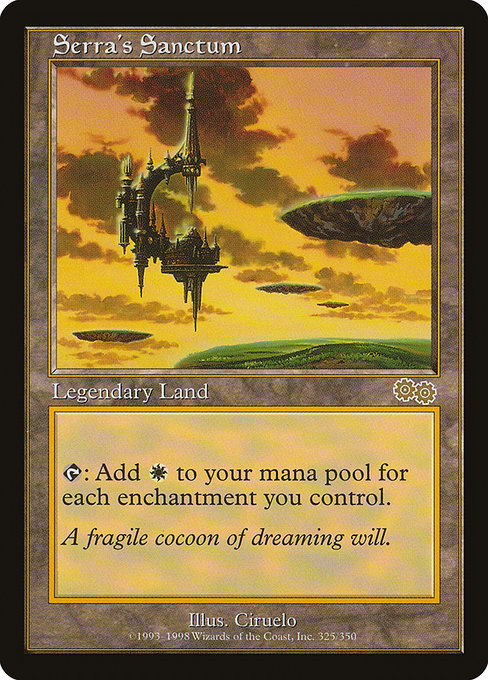

Naturally this makes lands like Ancient Tomb, Serra’s Sanctum, and Nykthos, Shrine to Nyx prime tutor targets for a lot of white decks, but if you’re trying to find missing colors of mana in multicolor decks, simply being able to snag a Raugrin Triome or Temple Garden can also make the difference between getting off the ground or getting mana screwed.
As a game goes on, one of my favorite ways to use Weathered Wayfarer is to find lands that can help keep my land count just under the player with the highest while still advancing my mana or other agendas.
For example, Strip Mine and Wasteland can sacrifice themselves to take other problematic lands off the table. Karoo actually lets you produce more mana with the same number of lands by returning one of your Plains to your hand, and lands like Buried Ruin can help retrieve a mana rock or another key artifact lost early in the game.
As powerful as Weathered Wayfarer can be, however, you just can’t get the instant gratification many Commander games require today. It’s a creature, so it’s vulnerable to popular removal, and it requires a way to gain haste or time to let summoning sickness wear off.
If you clear those hurdles, Weathered Wayfarer also costs a white mana to activate, which can be at odds with other early plays you’d like to make. In the late game, it’s also possible you’ll find yourself as the player with the most lands, either due to mana flood or minimal ramp from your opponents, making it an extremely unexciting 1/1 for 1.
I’m personally of the opinion that Weathered Wayfarer reads better than it plays in more cases than not nowadays, but in the cases where it has a chance to shine, it can really steal the spotlight.
Tithe

Tithe is simultaneously useful and frustrating. Its low mana cost makes it accessible on turn 1, but I’ve often found this is a better play on turn 2 or 3 so you can get your second plains after a Nature’s Lore or Cultivate hits the table. Being an instant, you can also cast Tithe at the end of an opponent’s turn, allowing you to pace your plays as you please.
It notably also lets you get any plains card, so Godless Shrine and Tundra are valid targets beyond basic lands. I wouldn’t recommend playing Tithe in any deck playing green, as it doesn’t put any lands you’re searching for into play, but ensuring you can start with 2-3 lands and an extra color or 2 of mana earns it a slot in many decks.
Regrettably, Tithe is on the Reserved List, so it is ridiculously expensive for the effect you get, but if you want an inexpensive alternative that is slightly watered down, Gift of Estates plays reasonably well, trading instant speed and doubling its mana cost for a guaranteed 3 plains cards.
Boreas Charger
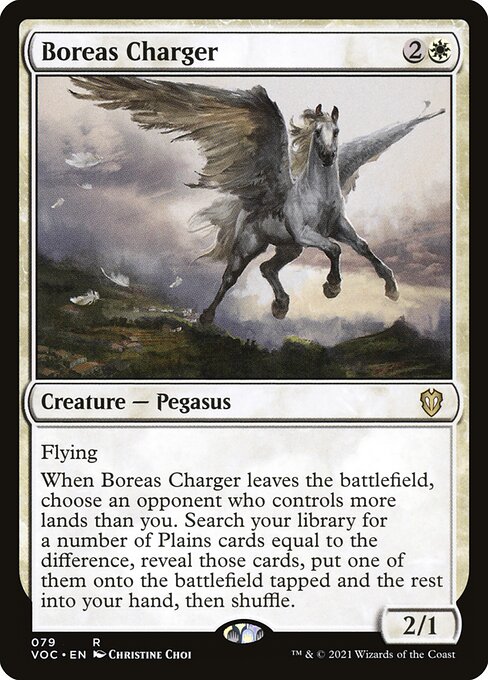
There has been a LOT of experimentation with white card designs that deal with land and mana ramp over the years, but for every few failed cards in the vein of Aerial Surveyor and Cartographer’s Hawk, you get a playable effect like Boreas Charger.
This actually came as a surprise to me, as conditional mana ramp that adds extra hoops to jump through beyond having fewer lands than your opponent is almost always unplayable, but when that hoop is “take this creature off the battlefield,” and the reward is both ramp and potentially filling your hand with any land with the Plains subtype, the results are surprisingly effective.
Whether you chump block with it, watch it get wrapped up in a Cyclonic Rift, or it becomes collateral damage of a Toxic Deluge, Boreas Charger has actually put in some solid work in my mono-white decks, as well as occasional work in non-green multicolor builds.
Occasionally you’ll be discarding excess lands, but the opportunity to thin your deck of multiple dead draws is usually well worth it in those scenarios. Otherwise, snagging 1-3 lands is the norm, and you get to put one into play to boot.
With reanimation spells and a sacrifice outlet, you can also take more control of the ramp and land tutoring, keeping you on pace with the greediest ramp players. Given the wide array of applications, I’m genuinely surprised this card doesn’t see more widespread play.
Keeper of the Accord

If you’re asking 4 mana for a mana ramp effect, the card in question has to pay off in a big, big way, as ramp often needs to smooth out early land drops and is sometimes critical for getting you off the ground in a game of MTG.
Keeper of the Accord can absolutely do this – on the condition it survives to see at least 1-2 opposing end steps. Serving as an important bridge between the early game and the mid game, getting access to both chump blockers and free land drops can help you catch up quickly when you’ve fallen behind the rest of your Commander pod.
Like many catch-up cards, however, Keeper of the Accord‘s effectiveness directly scales with how many opponents are ahead of you, and can be an absolutely dead card if you’re already winning.
This is a common complaint with white’s catch-up ramp cards across the board, but none really exemplifies this flaw more than this one, as it checks every opponent’s board individually rather than letting you choose the player who is furthest ahead.
Oreskos Explorer
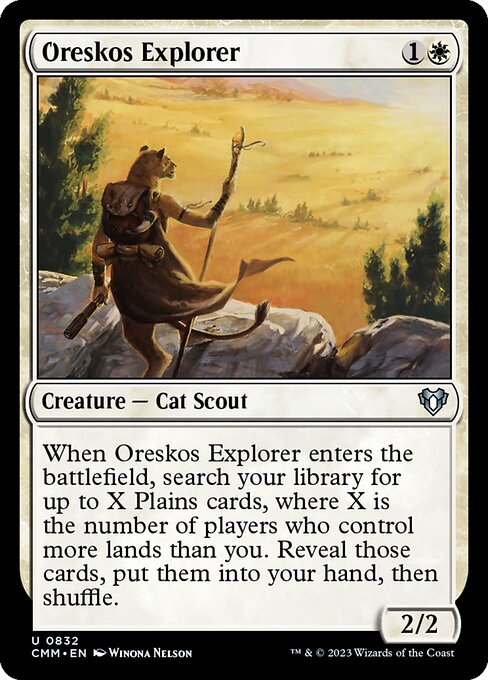
Seeing Oreskos Explorer rank so much more highly than Tithe might surprise some of you, but the difference between this effect being stapled to a creature versus an instant or sorcery is night and day. Usually you’ll only get 1 or 2 plains cards, but if you went last in your game of 4 players, you can easily snag 3 lands as early as turn 2 with no setup.
In addition to the ease of reusing and abusing this effect with reanimation cards like Sun Titan, being a creature makes Oreskos Explorer a great source of early damage or a deterrent for those trying to inflict early damage on you.
Its creature type is also pretty relevant nowadays, as Cat tribal or “Catmander” decks have a pretty dedicated following that has only grown since the original printing of Oreskos Explorer in Commander 2015.
Smothering Tithe

If you’re looking for a 4 mana acceleration card that always delivers what it promises, Smothering Tithe is your enchantment.
Easily the most powerful white mana accelerator printed in recent memory, this dials the obnoxiousness of Rhystic Study up to 11, rewarding you with treasure tokens instead of extra cards.
Good on its own or in combination with wheel effects like Windfall, Smothering Tithe will make a silly amount of mana if your table doesn’t know to get rid of it on sight.
While I’ve seen games where the caster of this enchantment has piles of treasure they helplessly look at, on the whole, this card will fuel the end of games if given the chance, and is one of the few white mana generators I would recommend for decks running green – it is just capable of doing that level of heavy lifting.
Weirdly, this is one of only 2 mana acceleration cards that leans on white’s affinity for taxing opponents, so I’d love to see more experiments like Monologue Tax explore this area of card design. Lord knows white needs all the help it can get with mana ramp and mana acceleration.
Knight of the White Orchid and Loyal Warhound
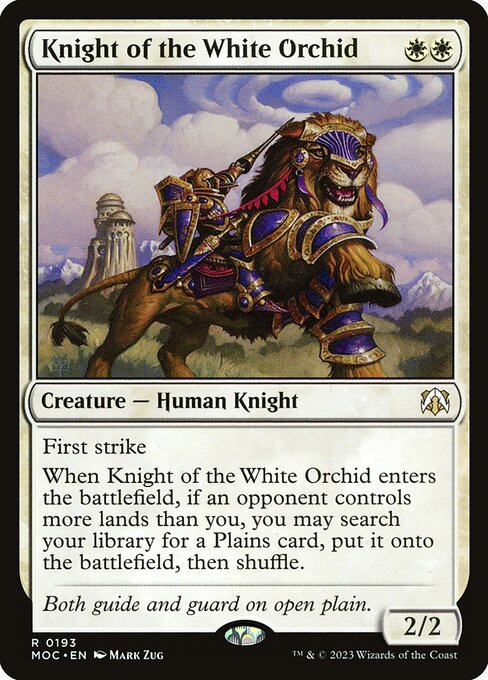
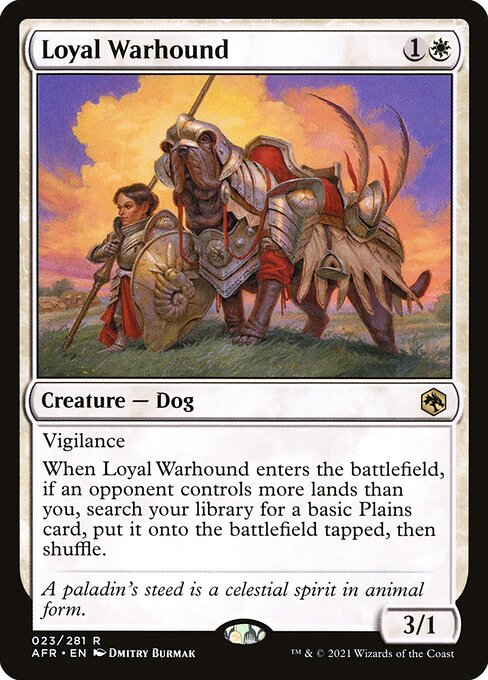
Knight of the White Orchid is one of my favorite white mana ramp cards ever printed, and one that I have played extensively since my Standard format tournament grinding days in Shards of Alara block. It gets any land with the plains subtype, rewards you for not going first, and brings the land you search for onto the battlefield untapped. All while giving you a 2/2 with first strike.
This is efficiency incarnate and insane value for 2 mana that only gets denied if you’re hit with a counterspell. And then we never got a low mana value white ramp card this good again. Over 10 years passed before we saw anything close, and then Wizards finally explored this design space again with Loyal Warhound.
Loyal Warhound, while not Knight of the White Orchid, is still a very solid card. Sure, it only gets basic Plains, and puts them into play tapped. Yes, a 3/1 creature with vigilance is more fragile than a 2/2 with first strike. White’s mana ramp is simply so mediocre that this is still a top-tier card in the color due to needing no dedicated setup and being useful in early turns.
This is a testament to just how good Knight of the White Orchid really is – even a heavily watered down version is still considered exceptional for white mana ramp. You should play both cards, but this stalwart knight is the superior card and why this unlikely pair of creatures ranks 3rd on my list.
If you aren’t able to find either of these cards or are looking for a third card that does Loyal Warhound‘s job a little less efficiently, you should also consider picking up Scouting Hawk from Commander Legends: Battle for Baldur’s Gate. 3 mana is a much bigger ask than 2, but it’s still a perfectly acceptable rate – especially in a color starved for mana ramp options.
Deep Gnome Terramancer

Deep Gnome Terramancer is going to be an instant mainstay of white Commander decks, and it isn’t difficult to see why.
A 2 mana 2/2 creature that can be played in response to a fetchland like Wooded Foothills, a watered down version like Fabled Passage or Terramorphic Expanse, a ramp spell like Three Visits, or another means of cheating cards into play like Kodama of the East Tree in order to ramp out one Plains card from your deck is already good value.
The fact that it then has the ability to trigger up to once every single turn it’s out simply makes it the best mana ramp white has gotten in a long time, and a contender for some of the best value too.
A bold claim, I know, but let’s take a moment to compare Deep Gnome Terramancer to most of white’s other mana ramp spells:
- You don’t need to be behind your opponents in land count to trigger this ability
- There aren’t any extra mana costs you have to pay for this mana ramp effect (and unlike treasure generators, this ramp is also more permanent)
- Deep Gnome Terramancer only costs 2 mana, putting it on par with the rate found on many of green’s best ramp spells
- Like Nature’s Lore and Three Visits, you can fetch nonbasic Plains cards like Jetmir’s Garden
- The condition for this card’s effect happens all the time in Commander, and can be found on cards in most decks of any power level your opponents are playing – even precons!
Despite all these virtues, there is a catch – Deep Gnome Terramancer‘s effect is ultimately contingent on what your opponents are doing. If they don’t try to ramp their lands or simply get a slow start, this card might sit in your hand gathering dust, or you might have to play it to free up space in your hand before it can be used in response to a ramp effect or fetchland.
That said, between ramp’s ubiquity in Commander, the fact that ramping one land for 2 mana has been good enough for many cards to see consistent play in the format for years, and the risk that Deep Gnome Terramancer will be a dead card is minimal at best, and I’d call it a safe bet you’ll come out ahead far more often than not when playing this card.
Land Tax

I have a love-hate relationship with Land Tax. On one hand, it tutors for an insane number of basic lands, and you’ll never need to worry about falling behind the table in land drops while it remains in play.
On the other hand, it almost gives you too much land, and you’ll often find yourself dumping a bunch into the discard pile as you discard to hand size each turn.
There was definitely a period of time where I noticed my play patterns with the card were actively sabotaging my land drops later in the game, and during the early days of Commander, where big, splashy spells were king, I wrote Land Tax off as being more trouble than it was worth.
Today, however, Commander is a much, much sleeker format. Whether you’re a “filthy casual”, a competitive cEDH player, or somewhere in between these two stereotypes like me, efficiency is always a part of the conversation surrounding deck construction or deciding which preconstructed deck to buy.
In a world where mana curves are constantly being evaluated and slimmed down, Land Tax is shining more brightly than ever. Can’t use all your tutored lands? Pair it with Scroll Rack to turn your lands into card draw.
Worried about taking too many lands out of your deck? Either speed up your deck’s execution time or consider retrieving fewer than 3 lands until you can avoid discarding your cards.
Or just play Crucible of Worlds. Graveyard hate isn’t quite as common as it should be in Commander, so leaning on your graveyard as a resource is perfectly okay too.
TL;DR: Land Tax can be treated like a cudgel, constantly searching for 3 basic lands, thinning your deck, and filling your graveyard. It’s even an excellent card when used this way. But you can do so much more with it if you add a bit of finesse to how you use it, finding ways to spin its flaws into positives and making the most of how flexible an enchantment it truly is.
Archaeomancer’s Map

If you’ve followed Commander content for any amount of time, Archaeomancer’s Map was likely the card you were expecting at the top of this list, and there’s very good reason for that. A fusion of Gift of Estates and Burgeoning that guarantees you two basic lands, this artifact fuels its own ramp effect, making it the total package.
Most importantly, playing it is useful whether you’re winning or losing, despite the Burgeoning half being locked behind a catch-up mechanic.
I cannot stress what a big deal this is for white. A catch-up mechanic that doesn’t completely kill the card when you’re ahead is unheard of, and is something we need to see more of from Wizards of the Coast’s design team. Finally, we have a blueprint that shows you can make viable catch-up cards that won’t strictly get in the way of you closing the game.
Opponents of this card are usually concerned about new, powerful designs homogenizing the Commander format, and Archaeomancer’s Map is definitely an efficient enough card to be a talking point in that conversation.
That said, white has so few viable designs in the mana ramp space, there’s going to be some risk of that with any new mana ramp card designed for it.
There need to be enough viable options to choose from that we as players aren’t desperately grabbing for any option that looks even remotely viable, and Archaeomancer’s Map is a good first step in that direction.
Is White’s Best Mana Ramp Good Enough?
The short answer: yes. I’ve played every one of these cards in Commander, and while only some of them see consistent play in my decks today, all of them can bring more out of your mana base in a white Commander deck.
How many of them you play will vary depending on your budget, the colors of your deck, and your strategies and playstyle. If you’re also playing green, very few of these cards are going to hold up compared to green’s best mana ramp options.
For those who are not interested in spending $20+ on a single card, Oreskos Explorer and Knight of the White Orchid are likely to stand out compared to Smothering Tithe and Land Tax.
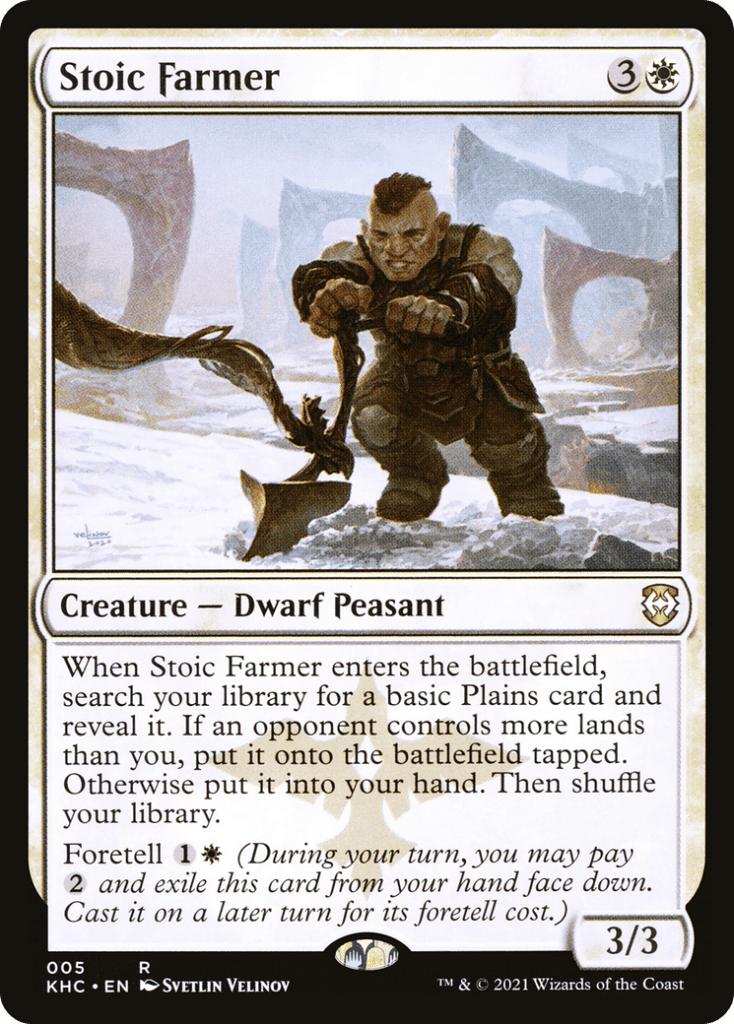
The long answer is naturally more complicated. Despite all the cards we talked about today being quite playable, there’s really no getting around the fact that much of white’s mana “ramp” is simply mana tutoring.
Most of the rest is heavily reliant on catching up to your opponents who are already ahead, making it difficult to actually get ahead yourself.
If you’re looking for additional, reliable ramp that doesn’t mind that you’re currently stomping the table and/or will actually increase your available mana beyond your land drop each turn, mana rocks (artifacts that generate mana) are often going to be necessary in order to supplement the handful of truly viable mana ramp options white offers.
Hopefully this artifact support transitions from “absolutely necessary” to “nice to have” for all white decks over time, but given what we’ve seen from most recent Commander products, it’s probably going to be a while before we’re at that point.
Other MTG Articles You Might Enjoy
- MTG’s Best Green Mana Ramp Cards for EDH
- MTG’s Best Mana Rocks for EDH
- Spelltable MTG Setup
- The Best Token Commanders in MTG
- How to Start Building an EDH Deck
Braden is a founder of Assorted Meeples and has been a gamer & writer with a vivid imagination all his life. Don’t believe us? Check out his excitement when meeting Goosebumps author R.L. Stine as a kid! An avid Magic: The Gathering spellslinger for over 15 years, you can always convince him to shuffle up for a game (or three!) of Commander.
